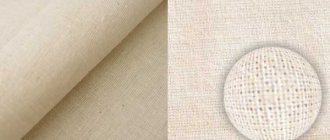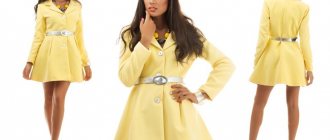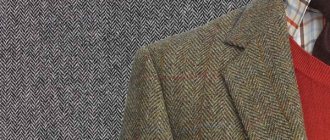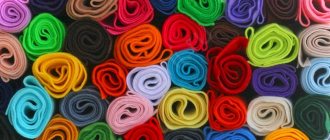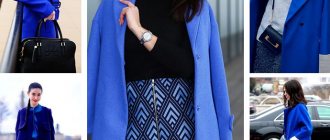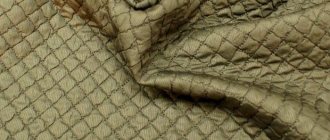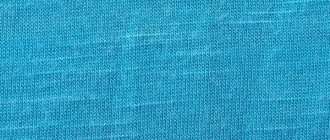Windproof and waterproof fabrics are suitable for protection from bad weather. They must be resistant to fading and tear-resistant. Raincoat fabric meets these requirements. This name unites a group of fabrics used for sewing jackets, raincoats, and coats. A distinctive feature of materials of this kind is resistance to moisture, while thickness, density, and elongation may vary. The same can be said about the composition. Most raincoat fabrics are of synthetic origin, but there are raincoat fabrics that contain cotton.
What is raincoat fabric
Waterproof materials include membrane, nylon or polyester, mixed varieties with impregnation. Raincoat and jacket fabrics include bologna, a synthetic material originally from Italy. It is made from nylon and treated with silicones.
Raincoat fabric has become a collective name for various materials used for sewing outerwear: jackets, raincoats, raincoats and even coats. It is made from artificial fibers and, if necessary, is subjected to additional processing. Natural threads are rarely used for the production of raincoat fabrics, and if they are included in the composition, they are necessarily reinforced with moisture-resistant impregnations.
There are several types of raincoat fabric. They differ in structure, manufacturing method, and composition. The production of raincoat fabrics, along with cotton and linen, is carried out by factories from Ivanovo, which are famous for their high-quality and affordable textiles.
Compound
Typically, raincoat fabrics are made from synthetics: nylon and other polyamides, polyester, acrylic. Initially, the composition of the raincoat fabric was natural. Liquid rubber was applied to a cotton base. The result was a moisture-resistant and windproof material.
Modern raincoat fabrics are made differently. Bologna, for example, is made from nylon with a silicone or polypropylene layer. Jordan jacket fabric contains polyester. The membrane material raincoat fabric is obtained from a microcellular coating applied to a base - polyester or other fabric.
Thick oxford fabric also belongs to raincoat fabric. It is made from polyester or nylon. The fabric can be so stiff and thick that it is suitable not only for making clothes, but also tents, awnings, etc.
Raincoat fabric - perfect style in any weather
The functionality of raincoats for shelter from adverse weather conditions was discovered by ancient hunting tribes. Back then, clothes were made from the skins of killed cattle. The Romans and ancient Greeks turned the wide material, casually hanging from the shoulders, into a real work of art, and this splendor was called chlamys. It was universal because it served not only as a wardrobe item, but could also replace a sheet or blanket and serve as a shelter.
Raincoat fabric in the forest
The famous Scottish chemist Charles Mackintosh was once conducting research in his laboratory and accidentally spilled rubber on his clothes. The scientist was wildly delighted with what he saw, because an ordinary cotton robe turned out to be waterproof. Mackintosh wasted no time and immediately patented the discovery, giving the matter his own name.
Another equally important fact occurred in the late 50s of the twentieth century. In the colorful and pretty Italian city of Bologna, they began to produce nylon fabric, the surface of which was covered with a thin layer of propylene. The resulting fabric gained worldwide fame; it began to be actively used for sewing trench coats, raincoats, capes, jackets, and coats.
Beige raincoat fabric
Today, raincoat fabric is in demand for sewing women's, men's and children's products.
Types and their properties
Do not think that raincoat fabrics are identical. Varieties of raincoat fabric can differ significantly from each other, like jacquard, linen for curtains or tulle mesh. Quilted raincoat fabric is adjacent to imitation leather, microcellular fabric displaces smooth polyester or polyamide. Types of fabric include smooth thin fabrics and insulated ones, for example, fleece raincoat fabric is ideal for sewing off-season clothing and suits for cool summer evenings and rainy weather.
Fabric varnish what is it photo
Raincoat fabrics vary in composition, properties, and design. Black raincoat fabric is suitable for sewing elegant trench coats, and printed fabrics are suitable for children's outerwear. White material is more likely to appear in a woman's wardrobe, and not every fashionista will dare to purchase a snow-white raincoat for bad weather, unless it is additionally treated with protective impregnations. Striped or checkered raincoat fabric is universal and suitable for both men and women.
Common types include:
- lacquer – nylon with twill weave and polymer coating. It looks like leather. Impregnated fabric is suitable for making raincoats and coats;
- Oxford is a nylon fabric with a matting-like weave. Relief fabric impregnated with polyurethane has a wide range of applications and is available in different densities;
- Dyuspo is a waterproof polyester used for sewing jackets and children's overalls. Does not rustle, soft, pleasant to the touch. Comes with additional impregnations and requires insulation;
- Taslan is a thin fabric with an interesting design. Suitable for making children's clothing and accessories. Just like cambric or plain acetate, it does not tolerate aggressive washing powders. It is recommended to wash such products with liquid soap or shampoo;
- membrane fabric is one of the types of raincoat material with improved characteristics. The membrane layer is applied to a different base, and the structure of the material can be different: two-layer or three-layer. The second type is considered more expensive, high quality and durable;
- Jordan is an unpretentious material from which jackets are made. Does not fade or wrinkle, but accumulates static electricity;
- quilted on padding polyester - quilted raincoat fabrics with insulation are widely used in sewing winter clothes. They delight with their affordable price, rich palette, and ease of care. Both the water-repellent layer and the insulation are of synthetic origin.
Duspo fabric - what is it? Photo
Raincoat fabric: composition and properties
Raincoat fabric is a fabric based on natural or synthetic fibers, and special impregnation provides water-repellent properties. The composition of modern paintings is very diverse. Cotton is often used for the base. However, it is not endowed with the characteristics necessary to withstand adverse weather conditions, so padding polyester or artificial threads are additionally added.
Composition of raincoat fabric
To make the fabric for a raincoat more comfortable, resilient, reliable and elastic, viscose or polyester, nylon, or nylon fibers are introduced into it. Thanks to this, the raincoat fabric receives the following characteristics:
- ability to repel water;
- lack of pickiness in care;
- aeration properties;
- practicality and long service life;
- crease resistance;
- UV resistance.
You might be interested in this How to work correctly with contours Decals for fabrics
Raincoat fabric is always in fashion. Roleplayers, travelers, and ordinary people adore her. This is what the Monker brand emphasized.
Advantages of raincoat fabric
In general, raincoat fabrics are inexpensive. This pricing policy allows them to be used for sewing a variety of products. Fleece fabric is used to make winter clothing. This material promotes comfortable wear even at sub-zero temperatures.
Advantages
Raincoat fabric has characteristic properties that are inherent in all varieties. It is valued for its resistance to moisture, wind, and mechanical stress. Some varieties are prone to fading, but most modern materials can withstand moderate exposure to ultraviolet radiation. Thin water-repellent material is suitable for making clothing. The denser varieties are used to make travel gear and equipment for hunters and fishermen.
The advantages of the material include:
- ease of care;
- aversion to pollution;
- durability, abrasion resistance;
- crease resistance;
- affordable price.
The raincoat is not very pleasant to the body, but direct contact with the skin is excluded. The material is used as a top layer and supplemented with either lining fabric or insulation - fleece, microfiber, etc.
Application area
Water-repellent fabrics are used primarily for sewing outerwear. A raincoat jacket will help out in the off-season. Designers offer classic and sporty models. Men's and women's raincoat jackets can be elegant and laconic.
In a child's wardrobe there is a place for a jacket in a bright palette made of quilted raincoat fabric. Insulated varieties of raincoat fabric will help out in winter. Raincoat with padding polyester 150 – 200 is suitable for temperatures down to -10ᵒC. Women's jacket with fur trim and padding polyester or cotton insulation 300 g/m2. m recommended for frostier weather. Down jackets made from raincoat fabric are better suited to a winter wardrobe, and lovers of voluminous and very warm clothes can purchase coats made of bologna with insulation.
The range of popular clothing includes trousers made of raincoat fabric, which usually come with insulation and elastic at the bottom, winter maxi skirts, vests, and raincoats. Raincoat fabric with padding polyester or fleece is suitable for sewing casual and sportswear. Loose winter pants or a tracksuit - men's or women's - will help out winter tourism lovers. The design of men's trousers is more practical and simpler.
Women's models of raincoat trousers can be more daring in palette and design. A raincoat skirt will complement an informal street look. A women's raincoat or coat made of raincoat fabric will most likely have a laconic and elegant design.
Raincoat fabric is used to make bags and backpacks, women's dutik-type boots, and hats. Men's raincoat fabric products have a dark palette. Women's products made from raincoat fabric - bags, clothes, shoes - are more original. You should not mix several items made of water-repellent material in one look: boots made of raincoat fabric do not look very good with bags or hats made of raincoat fabric.
Care
Typically, raincoat fabrics can be washed well at a temperature of 30 – 40 ᵒC. Gentle detergents are suitable for them. It is not difficult to remove stains if you do not store the contaminated product for a long time. For example, you can remove a greasy stain in the same way as with any other synthetic material - using dishwashing gel or toothpaste.
Nylon varieties do not tolerate aggressive chemicals, but polyester varieties are relatively unpretentious. In any case, do not use chlorine stain removers or bleaches. After washing, the items are hung on hangers and smoothed with your hands. This is enough to avoid creases and no additional ironing is required.
If you still need to iron clothes after washing or long-term storage in the closet, you will need a steam generator. It is advisable to use vertical steaming. You should iron raincoat fabric in the same way as silk, satin or crepe - at a minimum temperature and through the fabric.
It is more difficult to care for membrane tissues. Products made from microcellular material are sent to dry cleaning. This will allow you to quickly and safely clean your outerwear and preserve its heat-saving properties.
Dear readers of the Tkan.Club website, if you still have questions on this topic, we will be happy to answer them. Leave your reviews, comments, share stories if you have dealt with this material! Your life experience may be useful to other readers.
Application of fabrics with membrane
A membrane is not an independent fabric, but a thin material with which various fabrics are quilted. It is designed to protect against bad weather: strong wind, snow or rain. However, the membrane will not provide warmth in late autumn or winter cold, so it requires the creation of several layers.
The material has its own classification depending on its structure.
- Double layer. The fabric is distributed between the lining and the main fabric.
- Three-layer. The main fabric, lining and membrane are connected to form a single fabric.
Breathable fabric with a membrane
If in the first case, a membrane lining is a budget option, then in the second, the creation of several layers makes the fabric more reliable, resilient and elastic, which significantly affects production costs.
Also, fabric with a membrane is porous and non-porous. Thanks to the first structure, steam and moisture are repelled, and the second accumulates steam on the inner surface.
The advantage of the material is reliable protection from adverse weather conditions, ease of care, comfort to wear, and elasticity.
The disadvantages include the high cost of products and the need for care.
- To clean the products, you can use machine wash, but choose a gentle cycle.
- The water temperature should not exceed 300°C, so as not to damage the coating.
- It is strictly forbidden to use washing powders, as they do not allow the fabric to “breathe”, clogging the pores.
- Do not twist or wring out clothing. It is recommended to let the water drain on its own.
- You need to dry the product horizontally, carefully smoothing it with your hands.
- Ironing and dry cleaning of products is prohibited.
To prevent the membrane from losing its positive properties, experts advise periodically spraying clothes with sprays containing a large amount of fluorine. Items made of membrane material should be stored in a case so that the pores do not become clogged with dust.
Features of fabrics with membrane
Note! These fabrics are not intended for everyday wear. They are often used for sewing ski suits and workwear for people whose field of activity involves working in adverse weather conditions.
You might be interested in what types of cellular tissue there are, features of the English cell
Designers of children's clothing began to actively use the material, explaining this by the fact that the membrane will warm the most active and inquisitive in winter.

